
Für eine deutsche Übersetzung dieser Seite einfach die Brandenburger Flagge anklicken
 |
Click the Brandenburg Flag for a German translation Für eine deutsche Übersetzung dieser Seite einfach die Brandenburger Flagge anklicken |


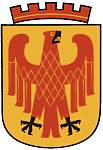 |
Home Towns - Potsdam, GermanyPotsdam's Rulers throughout the Centuries1415 - 1688 |
 |


 |
This site is part of our Potdam, Germany site. Click the left turn sign to get back to the Potsdam start site. |


 History is not made by individuals, but by people. However, the history made by the people is often associated with the rulers of the time. Here is a list of those who took credit and blame for Potsdam's history. We are not trying to compete with Wikipedia's comprehensive list of Rulers of Brandenburg although we have been trying to fill in some blanks here and there. Biographical references are generally limited to events affecting Potsdam and/or Brandenburg. The dates under the names don't refer to birth and death but rather to the time in office. Blue links lead to sites with more information, in most cases to a Wikipedia article. In some cases, we couldn't find an article in English language; in this case, Green links lead to articles in German language.
|
 |
Click the left-turn sign to get back to the previous section. Or, if you are interested in a different time period, click the U-turn sign to get to the "Rulers" start page. |
 |


 
|
Frederick I 1415 - 1425  At the Council_of_Constance in 1415, German King Sigismund enfeoffed Frederick, Burgrave of Nuremberg, with the Brandenburg Margraviate. Frederick earned his title by crushing the robber barons nuisance in the province a year earlier.  The Family of Hohenzollern had been Burgraves of Nuremberg since 1105. Now, Frederick I became progenitor of the Hohenzollern Dynasty in Brandenburg that would last for 15 generations all the way to the end of World War I. |
 Biography at Wikipedia
Biography at Wikipedia
|

 
|
John the Alchemist 1425 - 1440  Frederick I remained Prince-elector until he died in 1440, but in 1425, he turned the regency of Brandenburg over to his son Johann. We don't know much about Frederick's first-born son, there isn't even a picture (the picture to the right is a product of fantasy). We know that he added the Uckermark to Brandenburg's territory and that he was a successful negotiator in quarrels Brandenburg had with its northern neighbor Mecklenburg.  Johann was called "The Alchemist" for his interest in alchemy and medicine. He discovered the healing properties of garlic and is hailed for its introduction to Germany. |
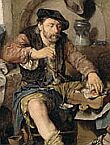 Biography at Wikipedia
Biography at Wikipedia
|

 
|
Frederick II "The Iron Tooth" 1440 - 1470  Johann didn't have a male heir and was therefore passed over in the line of succession. Frederick's second-born son Frederick II took regency of Brandenburg in 1437 and became the Hohenzollern's second Prince-elector after his father's death in 1440. Here was a sovereign who was truly interested in the welfare of his reign. He was offered to become King of Poland and Bohemia but refused the crown in favor of the Brandenburg Margraviate. He ensured the safety of Brandenburg's borders in treaties with its most influential neighbors Mecklenburg, Saxony and Hesse. In a 40,000 Gulden acquisition from the Teutonic Knights, he added Neumark to Brandenburg's territory. During his time on the Brandenburg throne, Potsdam developed into a town with a major, a judge and a number of trade guilds.  He moved his residency from Brandenburg/Havel to Berlin (though Brandenburg still remaind the Margraviate's capital) and built the first palace in what later became Germany's capital. At the same time, he cut many of Berlin's mediaeval city privileges in favor of a centralised monarchy. |
 |

 
|
Albert III "Achilles" 1470-1473  A year before he died, the Irontooth abdicated the throne and passed the Brandenburg scepter on to his younger brother Albrecht, who was called "Achilles" for his knightly qualities. Albrecht Achilles quickly got engaged in Brandenburg's administration. In the 1472 Treaty of Prenzlau he added the Uckermark to Brandenburg's territory and also brought the rest of Pomerania under the supremacy of the House of Hohenzollern.  In 1473, he issued the Dispositio Achillea which decreed that the Margraviate of Brandenburg should always descend in its entirety to the eldest son, thus saving Brandenburg's territorial integrity. Shortly after that, after a reign of only three years, he passed the regency of Brandenburg to his son, but he remained Prince-elector until his death in 1486. |
 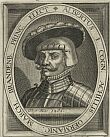 Biography at Wikipedia
Biography at Wikipedia
|

 
|
John "Cicero" 1473-1499  John was nicknamed Cicero for his eloquence and his profound knowledge of the Latin language. He was 18 years old, when his father Albert Achilles entrusted him with the Brandenburg throne.  Homeland of the House of Hohenzollern was originally Hohenzollern-Hechingen in South Germany and Albert ruled Brandenburg while living in the south German family estate, like his grandfather, his father and his uncle before him, and like the Wittelsbacher and Luxembourgian rulers before them. John broke with that custom and permanently resided in Berlin.  In 1486, after the death of Albert Achilles, John became Prince-elector and declared Berlin his primary residence, thus making it Brandenburg's capital. His final resting place is the Berlin Cathedral, making him the first Hohenzollern ruler who was put to rest in Brandenburg. |
  Biography at Wikipedia
Biography at Wikipedia
|

 
|
Joachim I "Nestor" 1499 - 1535  Joachim I was the first offspring of the House of Hohenzollern who was born in the Brandenburg Margraviate. For the first time since the end of the Ascanian line, the land had a ruler who was native to Brandenburg's soil. However, there still were noble families in Brandenburg that traced their native line back to the time of the Ascanians or even to the time of the Hevelli Princes. They still considered the Hohenzollern invaders and demanded their share of the province's growing wealth. With that, Brandenburg had to endure a resurgence of the "Robber-baron nuisance." |
 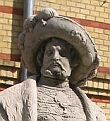 Biography at Wikipedia
Biography at Wikipedia
|
He was only 15 years old when he took over Brandenburg, but from the start, he fought a fierce and successful battle against the native
robber-barons and had 146 of them punished within just a few years. In 1502, he open displayed the cut-off head of his greatest enemy, Count
Otterstedt auf Dahlewitz. In his defence, Joachim later said. "I never spilled the blood ofe noblemen, I only executed rouges, robbers and
murders."
 Joachim was not only a warrior but also a thinker. With the foundation of the Margraviate's first university, the Alma Mater Viadrina in 1506 and the institution of the Berlin Supreme Court, he proved worthy of his given name "Nestor," meaning "Wise Mentor."  Joachim's reign coincided with the beginning of the Protestant Reformation. Joachim was known for his pugnacious adherence to the Roman Catholic faith and decreed in his will that Brandenburg should forever remain Catholic. At the same time he had to witness his wife's conversion to the new religion. |

 
|
Albert of Mainz 1499 - 1506  Albert was Joachim I's younger brother. After their father's death, both brothers co-ruled Brandenburg, both holding the title Margrave (but only Joachim held the electoral rights coming with the title). In 1506, Albert abdicated the Brandenburg Throne in favor of an ecclesiastical career. In 1513, at the age of only 23, he became archbishop of Magdeburg and five years later, in 1518, he was made cardinal. At the same time, he became one of Germany's four Archchancellors and with that, the House of Hohenzollern had achieved what it couldn't get with a co-reign in Brandenburg: two votes in the German Diet. |
 Biography at Wikipedia
Biography at Wikipedia
|
| As administrator of the Diocese of Halberstadt, Albert had obtained permission from the Pope to conduct the sale of indulgences to obtain funds to repay a substantial loan he had borrowed from Jacob Fugger. Half the collection was forwarded to the Papacy. It was this practice that disgusted a young Augustinan Monk named Martin Luther so much that he wrote his famous 95 Theses. October 31, 1517, the day when Luther sent his Theses to Albert (and also nailed them to the door of Castle Church in Wittenberg), is commonly considered the beginning of the Protestant Reformation and though it was initiated by Martin Luther, it was Albert of Mainz who provided the reason. |

 
|
Joachim II "Hector" 1535 - 1571  Joachim I decreed in his testament, that the Margraviate Brandenburg should be split between his two sons. This was a direct violation of the law laid down by his Grandfather, but nevertheless, when Joachim I died, his oldest son, Joachim II became Margrave, but his second son was entitled to large parts of Brandenburg, which now became a new province, called Brandenburg-Küstrin.  Joachim II's reign fell in a time when Germany was deeply divided between Catholics and Protestants and his personal life - torn between a Catholic father and a Protestant mother is exemplary for the turmoil of the era of the Lutheran Reformation. Joachim signed an inheritance contract in which he promised his father to remain Roman Catholic. He kept his promise until four years after his father's death. He also married a Catholic princess and promised her father, Sigismund I of Poland and Lithuania to never force her to convert. |
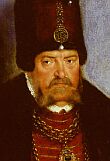 Biography at Wikipedia
Biography at Wikipedia
|
On November 1, 1539, the Margrave attended a Lutheran service at St. Nicholas Church in Spandau and received the
Holy Communion. Although Joachim never officially
ordered his subjects to follow his lead, the date is commonly considered the beginning of the Lutheran Reformation in
the Brandenburg Margraviate.
 Joachim's efforts to achieve a peaceful coexistence of all varieties of faith laid the foundation for a high level of religious tolerance that would be one of Brandenburg's finest attributes for centuries to come.  In 1510, under his father's rule, after an alleged host desecration all Jews in Brandenburg were forced to leave the country (actually 38 Jews were burned on the stake in Berlin that year). In 1543, Joachim II invited them to come back. His reasons may have been mostly economical, but still, at a time when the entire country was up in arms over the right religion, Joachim II demonstrated an enormous degree of tolerance. |

 
|
John George "Oeconomicus" 1571 – 1598  Only ten days after the death of Joachim II, his brother John, margrave of Brandenburg-Küstrin also died. John didn't leave a male heir and thus, Brandenburg was reunited under John George, son of Joachim II and nephew of John.  John George was a rather conservative ruler and didn't apply any big changes. Probably a wise decision; after all, his father Joachim II left him with a debt of 2.5 million gold coins. John George's successful consolidation of Brandenburg's finances earned him the nickname "The Economist." |
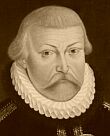 Biography at Wikipedia
Biography at Wikipedia
|
| On the downside, it must be noted that he started the supression of Jewish people yet again and ordered all of them to leave Brandenburg in 1573. This injustice wasn't corrected until almost 100 years later by the Great Elector Frederic William. |

 
|
Joachim Frederick 1598 - 1608  Joachim Frederick only ruled for ten years and his reign was rather uneventful. However, he earned merits for the construction of one of Europe's oldest artificial waterways, the Finow Canal, connecting Brandenburg's main rivers Havel and Oder. |
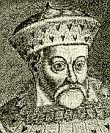 Biography at Wikipedia
Biography at Wikipedia
|
 
|
Katharina of Brandenburg-Küstrin 1598 - 1602  Katharina was married to Joachim Frederick since 1570. She is listed here because the Margrave ruled the land, but technically, he didn't rule Potsdam. Following a family tradition, he signed the town over to his wife right after he assumed the post of margrave.  Katharina was hailed for her charitable work in Berlin, taking care of the poor in the residency. Using the proceeds of her dairy farm, she ran a pharmacy in Berlin, handing out free medication to those in need. Now, it was time to take care of herself. In the few years she had left, she had Potsdam's 250 year-old renaissance-castle raised to the grounds and had her own castle, the so called Katharina-Building built. |

|

 
|
John Sigismund 1608 - 1619  History would probably not remember the ninth margrave of the House of Hohenzollern, had it not been for a momentous marriage. In 1594, John Sigismund, son of the Margrave of Brandenburg married Anna of Prussia, daughter of the Duke of Prussia. When the duke died in 1618, the Margrave of Brandenburg inherited his title, and from now on, the Central-German Margraviate of Brandenburg and the East-German Duchy of Prussia were ruled in personal union and were soon called Brandenburg-Prussia. |
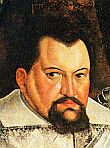 Biography at Wikipedia
Biography at Wikipedia
|

  |
George William 1619 - 1640  George William's reign was marked by the longest and deadliest war Europe had seen so far. Ever since the Lutheran Reformation, tension in Europe was rising. In 1618, the conflict became violent and for the next 30 years, Germany's more than 100 principalities as well as almost all European powers were engulfed in a war that would shape history for centuries to come.  George Wiliam was allied with the (Catholic) German Emperor Ferdinand II, as well as with his brother-in-law, (Protestant) Swedish King Gustav II Adolph. The Margrave's balancing act between the two main opponents in the European conflict resulted in Brandenburg being ransacked by both sides and George Wiliam fleeing to Konigsberg in Prussia, in Germany's save far east, leaving Brandenburg at the mercy of the Warlords of the Thirty Years War. |
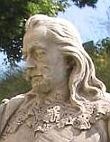 Biography at Wikipedia
Biography at Wikipedia
|

|
Here are some of the military leaders of the Thirty Years War. At one time or another, each one of them had control over Potsdam. |


|
Christian IV of Denmark
 Christian IV was King of Denmark and Norway from 1588 until his death in 1648. He joined the Protestant powers of the war in 1625 and at first gained some successes. He was later utterly routed by Imperial troops under Tilly (1626) and Wallenstein (1627).  In 1626, marauding Danish soldiers were the first of many to loot Potsdam. |
 Biography at Wikipedia
Biography at Wikipedia
|

|
Ernst von Mansfeld
 Without doubt, this was one of the most colorful characters in the 30-Years-War theater. Although Roman Catholic himself, he allied himself with the Protestant forces, first fighting on Bohemian side in 1621. Later he served Christian of Brunswick and then the Netherlands. Aa a mercenary and a leader of mercenaries, Mansfeld often interrupted his campaigns by journeys to raise money and recruit more troops. In 1624, he went to London, and in 1625, his new army of "raw and poor rascals" sailed from Dover to the Netherlands and joined Christian IV only to join the Danes in their defeat. Ironically, Mansfeld did not die on the battlefield but of a disease he contracted when fleeing from Wallenstein.  His beaten soldiers joined marauding Danes and together they pillaged Potsdam several times in 1626.
|
 Biography at Wikipedia
Biography at Wikipedia
|

|
Albrecht von Wallenstein
 Albrecht Wenzel Eusebius von Wallenstein was arguably the most famous general of the Thirty Years War. He was supreme commander of the armies of the Habsburg Monarchy, serving Holy Roman Emperor Ferdinand II. Wallenstein lead numerous successful campaigns but in a maze of intrigue, rumor and distrust, he was assassinated in 1634.  For the towns he conquered, Wallenstein introduced a "War Tax." After he marched into Brandenburg in 1627, Potsdam was taxed for three years to come. |
 Biography at Wikipedia
Biography at Wikipedia
|

|
Gustav II Adolph of Sweden
 Swedish King Gustav Adolph joined the Protestant side of the battle in 1630, pushing into North Germany and soon advancing into the heart of Germany. Until this day, the lines he reached at the high point of his campaign mark the boundary between Germany's Protestant north and Catholic South. He was killed in 1632 at the Battle of Lützen.  In 1631, Gustav Adolph took Potsdam with 16,000 soldiers. |
 Biography at Wikipedia
Biography at Wikipedia
|

  |
Frederick William, "The Great Elector" 1640 - 1688  Frederick William became Margrave of Brandenburg at the end of the Thirty Years War. He took over a land lying in shambles. Within a relatively short period of time, he managed to bring the Margraviate back on its feet. As a diplomat, he received Prussia's recognition as an independent state by the King of Poland and as a military leader, he smashed the reputation of the Swedish Army which was considered unbeatable, until Frederick William's troops beat them in 1675 at the Battle of Fehrbellin. The victory earned him the title "The Great Elector." In the following three years, Frederick William drove the Swedes not only out of Brandenburg but also conquered Swedish occupied Western Pomerania. |
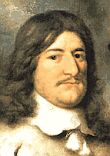 Biography at Wikipedia
Biography at Wikipedia
|

| In 1660, the Great Elector declared Potsdam to be his second residence, next to Berlin. His greatest accomplishment for the Margraviate and especially for Potsdam was his famous proclamation of 1685, the Edict of Potsdam. In a country torn apart by religious controversies, Frederic William supported religious tolerance. In a declaration of religious tolerance, he addressed exiled Huguenots (French protestants) and invited them into his nation. Not just French, but persecuted peoples from many other nations like Russia, Holland and Bohemia followed the call, making Potsdam a center of European immigration and a safe haven of religious freedom. In the fifty years following the declaration, Potsdam's population grew from 1,500 to 5,500. |


|
The Prussian Kings 1688-1871 Since 1618, Brandenburg's Margraves and Prince Electors were Dukes of Prussia. In 1701, Frederick William's son Frederick, who became Margrave in 1688 was crowned "King in Prussia," laying the foundation for the rise of Prussia as a European super power. |
 |
Click the right-turn sign to continue to Part 5 of our
Potsdam's Rulers Through the Centuries site, covering the Kings and Emperors of the Hohenzollern Dynasty (1688-1918). Or click the u-turn sign to returne to the "Rulers" start site. |

|


 Back to Potsdam Page |
 Back to Home Towns |
 Back to Germany Page |
 Back to English Main Page |
 Back to Start Page |